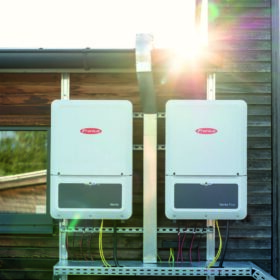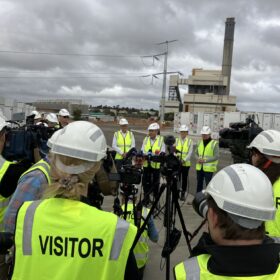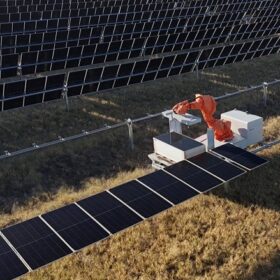Australia’s first electric lightbulb was installed in Sydney in 1863. For 130 or so years following that milestone, the electricity markets in Australia were planned, operated and regulated by state government-owned electric utilities.
When brown coal was found in the Latrobe Valley in the early 1900s, the State Electricity Commission of Victoria – which was established in 1921 – designed, engineered, constructed, operated and regulated the generation, transmission and use of power from it. The same goes for the Snowy Hydro, Hunter Valley and central Queensland energy reserves. As a result, Australia developed a state-controlled and funded “hub and spoke” model of supply and demand – large thermal generators based near their fuel supply connected to their city-dwelling customers by a centrally planned, high voltage transmission backbone.
Fast forward to the early 1990s, when the bulk of Australia’s current generation fleet and transmission network was in place and halfway through its operating life. We simultaneously deregulated, privatized and created the NEM to deliver greater operational efficiency across the generation and transmission fleet and, in theory, provide cheaper power for industry and consumers. Rules and regulations were designed, including transmission loss pricing, to fit the system that the architects of NEM inherited. And it served us well for the first 20 years of the NEM’s operation (let’s call it “NEM 1.0”).
It’s important to contemplate at this point that those rules were not responsible for building the system we inherited in the 1990s. The new rules were designed to deliver operational efficiency, not a transformation of the hub-and-spoke system. And they were never meant to deal with end-of-life decisions for generation, unless there was a like-for-like replacement in the same location. And we all know that is highly unlikely.
Roll forward through the 2000s and early 2010s, and Australia had started exploring the benefits of installing renewable energy to reduce carbon emissions from the country’s electricity sector. The aim at the time was to increase renewables generation from 10% to 20% by 2020 under the Renewable Energy Target (RET) legislation. At the same time, developers finished building what was likely to be Australia’s last coal-fired power station.
Tipping point
For the most part, the NEM and its rules accommodated the first 20 GWh of the RET’s 33 GWh target relatively easily, until the tripling of Australian domestic gas prices caused the marginal cost of thermal generation to increase accordingly. This converged with continually increasing wind farm efficiency and the halving of solar panel costs between 2012 and 2018.
These dynamics made new renewable generation cheaper to install than new thermal generation and, more importantly, made new renewable energy generation cheaper than existing thermal generation – a tipping point that analysts at McKinsey have said will also occur in the United States next year.
From then on the game changed. An economic tipping point had been reached, and the type and location of generation that will take us well into the second half of the 21st century – let’s call it “NEM 2.0” – has made many of the “hub-and-spoke” NEM rules obsolete at best, and a brake on transformation at worst.
Should this worry us? Yes. Is it fixable? Also yes. We know this as we successfully built a system throughout the 1900s based on connecting the most abundant and cheapest energy resources to our cities. However, in the same way that the NEM 1.0 rules did not build our first electricity transmission system, they are unlikely to be the tools that efficiently guide investment in NEM 2.0’s generation fleet or transmission network.
How do we know this? Look no further than the volatility of the marginal loss factor (MLF) over the last four years and the impact the transmission-loss pricing methodology has had on distributed generation in the NEM since the aforementioned tipping point was reached. Year-on-year MLFs have moved by up to 27% – unprecedented in the NEM’s history. The MLF rules and methodology no longer fit, and as a result are currently subject to a rule-changing process in which the Clean Energy Investor Group (CEIG) has played an active advocacy role.
CEIG represents 20 institutional investors who own 72 renewable power stations – 6.5 GW of operational or under-construction projects (15% of the NEM generation fleet, but 75+% of the most recently completed generation). Together they have drawn AUD 11 billion of investment. Importantly, they also represent 10 GW of new clean energy development projects and are the group most affected by the volatility that this NEM 1.0 rule is having on the NEM 2.0 generation fleet.
CEIG, along with many of Australia’s large energy user groups, has said that it is critical that predictability and volatility reduction are immediately applied to the transmission-loss calculation methodology, at least until a wholesale redesign of the NEM rules helps the Australian Energy Market Regulator’s (AEMO) Integrated System Plan come to life.
In its submission to the Australian Energy Market Commission (AEMC), CEIG proposes moving from the MLF calculation to an Average Loss Factor (ALF) methodology, which better approximates the actual losses for new generation at sites where resource density is highest, rather than where the hub-and-spoke transmission system is strongest.
The opportunity that this rule change brings is that it will allow the market transformation to continue in as orderly and efficient a fashion as possible – allowing renewable energy penetration to reach up to 29% in 2020, 50% in 2025 and 100% in the early 2030s, according to a 2018 Australian National University Report.
The risk of maintaining the status quo for forecasting transmission losses will at best require investors to include higher risk premiums to allow for MLF volatility. At worst, it could see investors completely withdraw from the market, as suggested by the Clean Energy Council last month in their Q2 2019 Market Report, which shows that investment in new projects has halved over the past two years.
Both of these outcomes could cause energy prices to rise sharply, based on CEIG’s own estimates and its adviser’s calculations, up to AUD 125 per year per residential customer.
Over the past two months, CEIG has undertaken a wide stakeholder consultation process and has been encouraged by the level of enthusiasm for the continued participation of this investor class in building more solar, wind and hydro in Australia. It said it is particularly pleased with the demonstrable effect it has had on reducing wholesale energy prices in the NEM over the past three years, while providing real competition for the state-run clean energy reverse auctions.
The outcome of the change from MLF to ALF will be announced in a draft determination by the AEMC on Nov. 21. CEIG is encouraging eveyone involved in the decision-making process to understand how we arrived at NEM 1.0 and the kind of institutional investors, clean energy projects and distributed generation projects that are needed to ensure a cleaner and cheaper NEM 2.0 – starting with this important rule change.
Marginal loss factors explained
Many people in Australia started talking about the risk posed to solar projects by marginal loss factors (MLFs) after the Australian Energy Market Operator (AEMO) announced a reduction to the MLFs of several operational solar farms. That decision affected the revenue these installations receive from the National Energy Market (NEM). Investment fund manager Infradebt describes MLFs as “a measure of the marginal transmission losses for a generator (or load) on the NEM,” and explains that they are put in place to account for energy losses between a generator site and the regional reference node.
MLFs can decrease or increase the revenue received by a generator. As an example, Infradebt notes a project with an MLF set at 0.98. This means the generator will receive 98% of the state pool price per megawatt-hour.
The reduction of MLFs by AEMO can be seen as a sign of grid congestion in certain regions of Australia. Generators satisfying local demand will have a higher MLF, but as more are built in a given region, that part of the grid becomes congested, and electricity has to be transmitted over longer distances, increasing transmissions losses and therefore leading to a decrease in the MLF.
Infradebt used the Broken Hill Solar Farm as an example. The project has seen its MLF reduced from above 1 in 2016 to 0.73 in 2019-20 – a drop in value of more than 40%. But this can be explained at least in part by the connection of a new wind farm that was developed by the same company that owns Broken Hill, so presumably it could account for the loss in value.
The views and opinions expressed in this article are the author’s own, and do not necessarily reflect those held by pv magazine.
This content is protected by copyright and may not be reused. If you want to cooperate with us and would like to reuse some of our content, please contact: editors@pv-magazine.com.








By submitting this form you agree to pv magazine using your data for the purposes of publishing your comment.
Your personal data will only be disclosed or otherwise transmitted to third parties for the purposes of spam filtering or if this is necessary for technical maintenance of the website. Any other transfer to third parties will not take place unless this is justified on the basis of applicable data protection regulations or if pv magazine is legally obliged to do so.
You may revoke this consent at any time with effect for the future, in which case your personal data will be deleted immediately. Otherwise, your data will be deleted if pv magazine has processed your request or the purpose of data storage is fulfilled.
Further information on data privacy can be found in our Data Protection Policy.